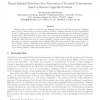CHES
2003
Springer
14 years 5 months ago
2003
Springer
A true random number generator (TRNG) usually consists of two components: an “unpredictable” source with high entropy, and a randomness extractor — a function which, when app...
CHES
2003
Springer
14 years 5 months ago
2003
Springer
CHES
2003
Springer
14 years 5 months ago
2003
Springer
Abstract. Balanced asynchronous circuits have been touted as a superior replacement for conventional synchronous circuits. To assess these claims, we have designed, manufactured an...
CHES
2003
Springer
14 years 5 months ago
2003
Springer
We introduce multi-channel attacks, i.e., side-channel attacks which utilize multiple side-channels such as power and EM simultaneously. We propose an adversarial model which combi...
ACNS
2003
Springer
14 years 5 months ago
2003
Springer
Distributed key generation is one of the most challenging tasks for threshold cryptosystems. Designing such a protocol and proving its security against a malicious, adaptive adver...
ACNS
2003
Springer
14 years 5 months ago
2003
Springer
Abstract. To gain access to account privileges, an intruder masquerades as the proper account user. Information from user feedback helps to improve the accuracy of classifiers use...
ACNS
2003
Springer
14 years 5 months ago
2003
Springer
Key exposures, known or inconspicuous, are a real security threat. Recovery mechanisms from such exposures are required. For digital signatures such a recovery should ideally —an...
ACNS
2003
Springer
14 years 5 months ago
2003
Springer
A (t, n) threshold signature scheme allows t or more group members to generate signatures on behalf of a group with n members, while any t−1 or less members cannot do the same th...
ACNS
2003
Springer
14 years 5 months ago
2003
Springer
Pseudonym systems allow users to interact with multiple organizations anonymously by using pseudonyms. Such schemes are of significant practical relevance because it is the best m...
ACNS
2003
Springer
14 years 5 months ago
2003
Springer
In this paper, we first propose a novel Public License Infrastructure (PLI) that uses cryptographic threshold secret sharing schemes to provide decentralized public license service...


